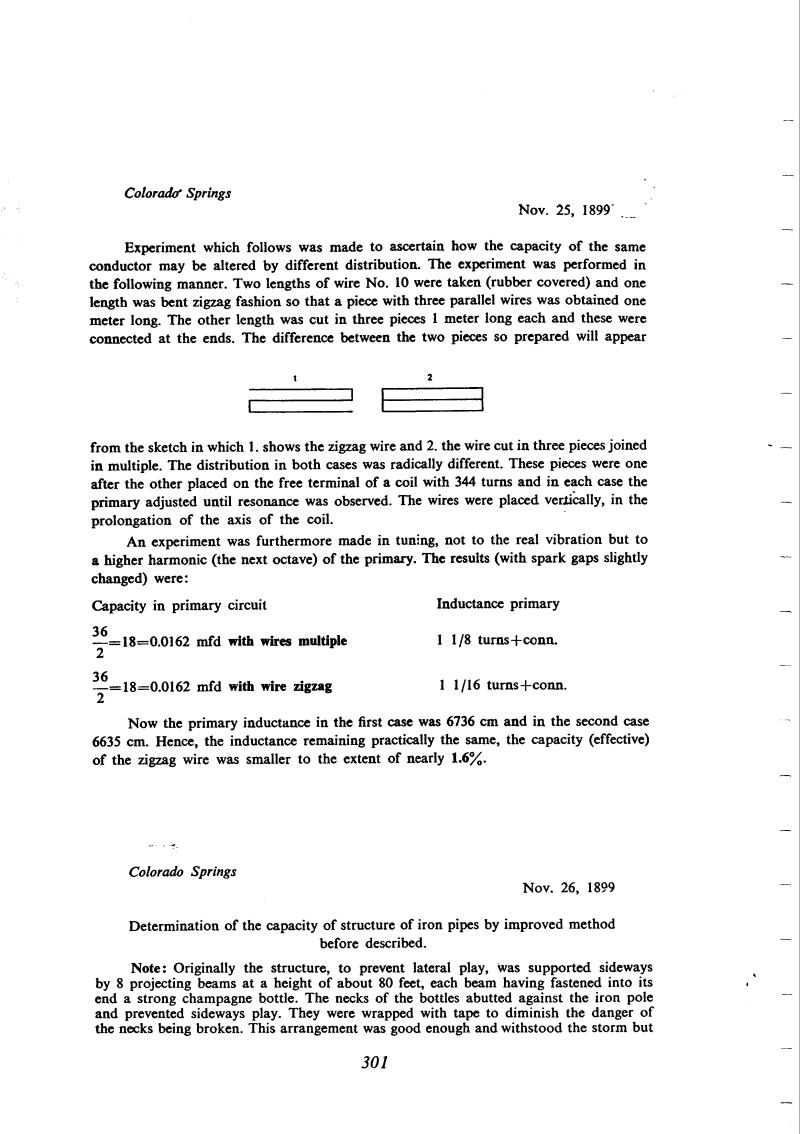
Nikola Tesla Books
Colorado Springs
Nov. 25, 1899
Experiment which follows was made to ascertain how the capacity of the same conductor may be altered by different distribution. The experiment was performed in the following manner. Two lengths of wire No. 10 were taken (rubber covered) and one length was bent zigzag fashion so that a piece with three parallel wires was obtained one meter long. The other length was cut in three pieces 1 meter long each and these were connected at the ends. The difference between the two pieces so prepared will appear from the sketch in which 1. shows the zigzag wire and 2. the wire cut in three pieces joined in multiple. The distribution in both cases was radically different. These pieces were one after the other placed on the free terminal of a coil with 344 turns and in each case the primary adjusted until resonance was observed. The wires were placed vertically, in the prolongation of the axis of the coil.
An experiment was furthermore made in tuning, not to the real vibration but to a higher harmonic (the next octave) of the primary. The results (with spark gaps slightly changed) were:
| Capacity in primary circuit | Inductance primary |
|---|---|
| $! {36 \over 2} $! = 18 = 0.0162 mfd with wires multiple | 1 1/8 turns + conn. |
| $! {36 \over 2} $! = 18 = 0.0162 mfd with wire zigzag | 1 1/16 turns + conn. |
Now the primary inductance in the first case was 6736 cm and in the second case 6635 cm. Hence, the inductance remaining practically the same, the capacity (effective) of the zigzag wire was smaller to the extent of nearly 1.6%.
Colorado Springs
Nov. 26, 1899
Determination of the capacity of structure of iron pipes by improved method before described.
Note: Originally the structure, to prevent lateral play, was supported sideways by 8 projecting beams at a height of about 80 feet, each beam having fastened into its end a strong champagne bottle. The necks of the bottles abutted against the iron pole and prevented sideways play. They were wrapped with tape to diminish the danger of the necks being broken. This arrangement was good enough and withstood the storm but
301
November 25
He performs one more experiment in order to determine the capacitance of a vertical conductor with various current distributions. Originally the experiment was uniquely thought up, and the new test is that he performs the adjustment with a harmonic frequency.
November 26
He gives the description of some details of the structure with metal sphere on top. He measures the capacitance of this system in combination with a coil with 344 turns and a new "additional coil". Earlier, on Nov. 7, he performed the capacitance measurement of the same structure, but without protective cover, and with the "additional" and experimental" coils. On Nov. 12 he performed similar measurement with coil of 1314 urns, and on Nov. 26 he recalls results of Nov. 7 with new "additional" coil. In the notes there is one more result with the "additional" coil, with the most improved method of determining resonance (please see Nov. 13). This result, which otherwise is quite different from others, is not mentioned on Nov. 26.
There is a remark at the end of the notes of Nov. 26 when he foresees the possibility of systematic errors in determining the resonant frequency and Tesla emphasized that this has to be checked.


